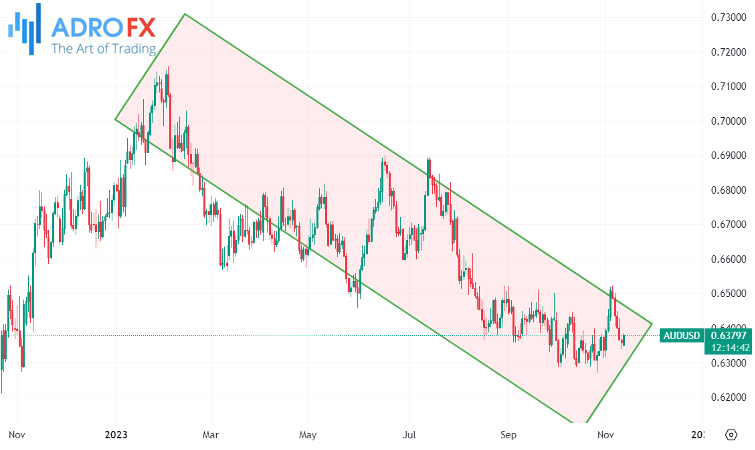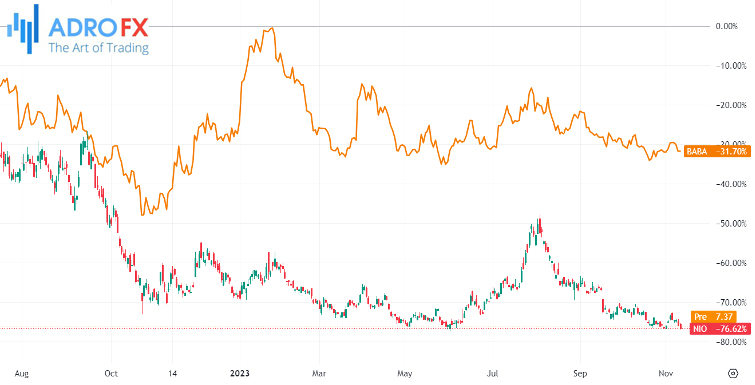China's Economic Evolution: Opportunities and Challenges in a Global Powerhouse

In recent decades, China's economic ascent has been nothing short of extraordinary. What was once a struggling third-world economy has blossomed into the world's second-largest, following closely behind the United States. Simultaneously, China has secured its place as the foremost global buyer of vital commodities like crude oil and copper. These profound shifts have irrevocably positioned the Chinese economy as an indispensable focal point for traders and investors across the globe.
Within the pages of this article, we embark on an exploration of the dynamic landscape of China's economy. Our journey delves into the reasons why this economic powerhouse is of such paramount significance and how it impacts both markets and investors. The story of China's economic transformation is rich and multifaceted, revealing its influence on various facets of the global financial landscape.
China's Economic Landscape: An Insight
China, the world's second-largest economy, is a global economic powerhouse with a GDP exceeding $17.7 trillion. The remarkable growth it has achieved is evident when one considers that its GDP was less than $60 billion in the 1970s. In two decades, China's GDP per capita has surged from under $1,000 in 2000 to a substantial $12,000.
China's economy is characterized by significant diversification. Real estate commands a dominant position, contributing to over 25% of the total output. Historically, real estate has been a lucrative investment avenue for many Chinese citizens, providing consistent returns.
Manufacturing represents another crucial pillar of China's economy. While it was initially associated with low-tech manufacturing such as textiles and footwear, China has evolved into a key player in high-tech sectors like aviation, semiconductors, and automobiles.
China extends its economic reach across several other industries, notably in tourism, agriculture, technology, and mining.
However, there are emerging signs that China's robust economic growth may have reached its zenith. The real estate sector, which has been a major driver of the economy, is showing signs of slowing down, leading to the collapse of prominent companies like Evergrande and Country Garden. Home prices have also experienced a sharp decline in recent years.
China's Role in Global Trade
China's significance in the global trade landscape cannot be overstated. Its immense population and high consumer spending power have made it a cornerstone for companies worldwide.
As the "world's factory," China is the largest consumer of vital commodities such as copper, iron ore, corn, soybeans, and aluminum. It sources these commodities from countries like Australia, the United States, Peru, Brazil, and Argentina.
China stands as the world's foremost exporter and importer. In 2022, it exported goods valued at over $3.5 trillion, showcasing a consistent upward trajectory in its exports. Key export destinations include the United States, Hong Kong, Japan, South Korea, and Japan, with the US accounting for 16.2% of China's exports.

Furthermore, China is a major importer, having brought in goods worth over $3.13 trillion in 2022, compared to $3.09 trillion in the previous year. Notable imports encompass machinery, precious gems and metals, vehicles, plastics, and copper.
The ongoing slowdown in China's economy carries substantial implications, as its interconnectedness in the global supply chain affects countries like Australia, which rely heavily on exports to China.
Factors Behind China's Economic Slowdown
China's economic deceleration can be attributed to several key factors. Firstly, the real estate sector, which has thrived for decades, is exhibiting signs of fatigue. This is partly due to China's debt control measures and the saturation of the housing supply.
The repercussions of a slowing real estate market are extensive, as land sales have historically been a primary source of revenue for local governments. The heavy debt burden of these local administrations raises concerns about their financial stability.
Secondly, China's economy is grappling with ongoing "de-risking" efforts as businesses seek alternative manufacturing sources. For instance, Mexico has emerged as a leading supplier for the United States, diversifying supply chains.
Thirdly, China faces demographic challenges, with a stagnation in population growth. A Brookings study predicts that China's population will dip below 1 billion by 2080 and below 800 million by 2100.
Other contributing factors to China's economic slowdown include rising tensions with Western nations, mounting debt levels, and subdued foreign direct investments.
Revitalizing China's Economy
Reviving China's economic growth poses a formidable challenge. Structural reforms aimed at stimulating long-term consumption are pivotal. Consumer spending, a primary driver of the US economy, can be bolstered through tax reductions and supportive measures.
China may consider gradually increasing its retirement age and implementing immigration-friendly policies. In contrast to the United States, China has historically exhibited reticence toward immigrants.
Crucially, China should work towards fortifying its relations with Western countries, particularly the United States. Resolving issues such as the Taiwan question is an area warranting attention.
Additionally, deregulation, especially in technology and financial services, can rekindle China's economic dynamism. The nation prospered when its light-touch regulatory environment paved the way for companies like Alibaba and Tencent to flourish.
China's Dominant Industries and Economic Influence
China, as one of the world's leading economies, holds a prominent role across diverse sectors. Notably, real estate stands out as the largest sector within China's economy, contributing to more than 25% of the total economic output and providing employment to millions.
The manufacturing industry is another pivotal force behind China's robust economic growth. Significantly, China has ascended to the top echelons of global vehicle manufacturing. Its manufacturing prowess extends to a spectrum of products, including machinery, smartphones, and computers.
Consumer spending is a thriving sector within China, with numerous consumer-oriented companies like LVMH, Kering, and Hermes identifying China as their primary market.
China, endowed with vast land resources, has positioned itself as a key player in the agricultural sector. The nation has allocated millions of acres of land for farming, to achieve self-sufficiency and reduce dependence on countries like the United States.
China's Impact on the Financial Market
In the realm of currency markets, China wields substantial influence. The primary currency pairs that react to China's economic data are the USD/CNY (US Dollar to Chinese Renminbi) and USD/CNH (US Dollar to Chinese Offshore Renminbi). CNY is utilized for trading within mainland China, while CNH is employed in regions beyond the mainland, such as Hong Kong and Singapore.
China's economic performance also exerts influence on the Australian dollar due to the volume of goods it exports to China. For instance, the Australian dollar experienced a decline in 2023 as China's economic recovery encountered headwinds.

China's economic events have significant repercussions on global stock markets, with particular attention directed toward stocks listed in Shanghai and Shenzhen. Additionally, the Hang Seng Index is closely monitored, as its constituents engage extensively in mainland China. Importantly, China's economic data and events have a ripple effect on stocks in countries like the United States and Europe, given the substantial business ties these nations maintain with China.
China's status as the largest purchaser of commodities, including copper, coal, natural gas, and aluminum, bears paramount significance in the world of commodities trading. Consequently, any signs of economic weakness in China can lead to declines in commodity prices. Such occurrences transpire because China typically reduces its commodity purchases when its economy faces challenges.
In the cryptocurrency domain, China has officially prohibited cryptocurrency-related activities for several years. However, its impact on the cryptocurrency industry remains undeniable. Reports reveal that Chinese customers constitute a significant portion, accounting for 20% of customers in the finance sector. Consequently, regulatory actions by Chinese authorities can have a pronounced impact on various cryptocurrencies.
Opportunities in China for Day Traders and Investors
China's dynamic economy presents compelling opportunities for both traders and investors. Notably, shares of certain Chinese companies with significant exposure to the domestic market have witnessed substantial price declines over time.
Prominent examples include Alibaba and Nio, whose shares are listed on American exchanges. This presents traders with the opportunity to engage in buying and selling these stocks, leveraging their insights into China's ever-evolving economic landscape.

Moreover, the deceleration of China's economy is causing significant volatility in commodities, particularly in the case of copper and crude oil. Savvy traders can capitalize on these market fluctuations by strategically buying when prices are at their lowest and shorting when prices reach their peak.
Additionally, a viable strategy involves shorting shares of struggling real estate companies in China. In recent years, notable firms like Country Garden and Evergrande have experienced substantial downturns, offering potential opportunities for traders to benefit from these declines.
Conclusion
As China's economic trajectory unfolds, it leaves an indelible mark on the world. The nation's impact is not confined within its borders; it reverberates through global economies, currencies, and markets. From the currency market, where the renminbi influences exchange rates, to the ripple effects on commodities, stocks, and cryptocurrencies, China's influence is far-reaching. Amidst these shifts and challenges lie opportunities for investors and traders to navigate the intricate Chinese economic landscape. The dynamic and evolving nature of China's economy offers a spectrum of investment prospects. Day traders and investors can leverage their insights and strategies to navigate this transformative journey, seizing moments of volatility in commodities, equities, and more. The intricacies of China's economy, both its strengths and vulnerabilities, continue to play a pivotal role in the global financial landscape, making it a captivating subject of study and a captivating arena for strategic endeavors.
About AdroFx
Established in 2018, AdroFx is known for its high technology and its ability to deliver high-quality brokerage services in more than 200 countries around the world. AdroFx makes every effort to keep its customers satisfied and to meet all the trading needs of any trader. With the five types of trading accounts, we have all it takes to fit any traders` needs and styles. The company provides access to 115+ trading instruments, including currencies, metals, stocks, and cryptocurrencies, which make it possible to make the most out of trading on the financial markets. Considering all the above, AdroFx is the perfect variant for anyone who doesn't settle for less than the best.










